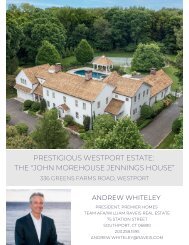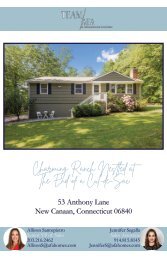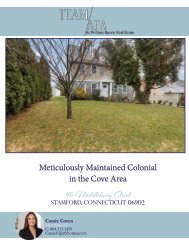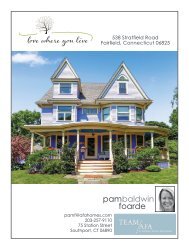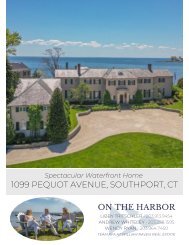108 Leeuwarden Rd Sideways Brochure
You also want an ePaper? Increase the reach of your titles
YUMPU automatically turns print PDFs into web optimized ePapers that Google loves.
Darien, Connecticut<br />
Until the advent of the railroad, Darien was a small, rural community of<br />
about one thousand farmers, shoemakers, fishermen, and merchants<br />
engaged in coastal trading. In 1864 during the Civil War, the first home for<br />
disabled war veterans and soldiers’ orphans in the United States was built at<br />
Noroton Heights, named after its founder, Benjamin Fitch of Darien. At the<br />
end of the Civil War, security and economic prosperity in the North brought a<br />
building boom. What had once been farmland and open space was divided and<br />
residences for prosperous businessmen and affluent local merchants blossomed<br />
on major streets including Brookside, Prospect, Mansfield, Noroton and<br />
Middlesex. A number of well-to-do New Yorkers discovered Darien’s picturesque<br />
shoreline and built summer homes in Tokeneke, Long Neck Point and Noroton.<br />
Darien was still a small town of a few thousand people in 1914, even though<br />
there were already a few hardy commuters here who taxied by surrey from<br />
home to station. After World War II, new streets and developed areas sprang up.<br />
The town center grew steadily along with the population. By the mid-1950’s the<br />
Connecticut Turnpike came through the town. General prosperity and growth<br />
continued until the population leveled off around 20,000 by 1970. Today<br />
Darien is a suburban community with an active town center, excellent schools,<br />
and involved residents. It offers unspoiled land and clear waters. Those who<br />
have come to live here have been careful stewards of its architectural and natural<br />
heritage while enjoying the resources of a modern community.








